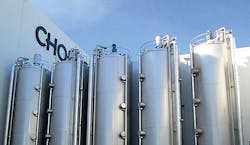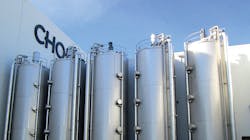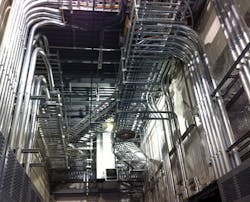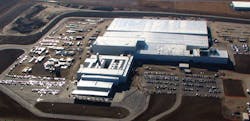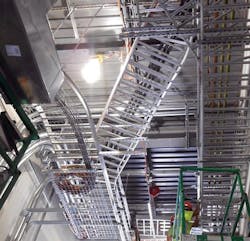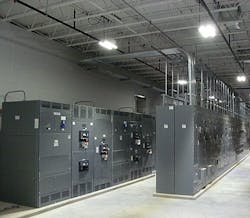Chobani Builds World’s Largest Yogurt Plant
At a million square feet, the world’s largest yogurt plant would have taken two years to complete on a traditional construction cycle. Through a design-build, hyper-track approach, however, Chobani, Inc. constructed its new $450-million plant in Twin Falls, Idaho, in just 10 months.
“At the time we were building this facility, demand was exceeding supply, and, as a result, Chobani was running out of product,” says Charlie Pavelec, senior vice president of electrical for Shambaugh & Son, L.P., an EMCOR Company that served as the design-builder, general contractor, and engineer on the project. “They needed to get the plant up and running so they could meet demand.”
Since 2007, Chobani’s brand has grown so quickly that it couldn’t produce enough Greek yogurt out of its New York plant to keep the store shelves full. To add more capacity, the company added a second yogurt processing facility in Idaho. The entire manufacturing process — from milk receiving to the creation of yogurt and packaging of the product — occurs under one roof at the new plant, which sits on about 200 acres.
Taking a design-build approach
To get the new plant up and running as quickly as possible, Chobani opted for a design-build approach. This integrated method delivers design and construction services under one contract with a single point of responsibility, according to the Design Build Institute of America (DBIA). As a result, project partners can often save time, cut costs, and improve the quality of the job.
In the case of the new plant project, Shambaugh & Son worked closely with Chobani to respond swiftly to any changes, finish the project ahead of time, and not incur any lost-time injuries. As a result, the project won the DBIA’s 2013 Design-Build Project of the Year award and the 2013 Food Plant of the Year award from Food Engineering magazine.
The design and construction team included Shambaugh & Son; MSKTD & Associates, Inc., the architect; Boccard Life Sciences; and the Tippmann Group, the civil/architectural/structural subcontractor. Shambaugh & Son was responsible for the site preparation as well as the design and installation of the mechanical, electrical, fire protection, and temperature controls, and process piping installation. The company also installed fiber optic and communications wiring for the plant and provided all of the site lighting, which included both LED and fluorescent luminaires.
Responding to changes
As one of the nation’s top yogurt producers, Chobani needed to build a plant that could handle future expansion. To power the plant, the electricians brought 15 electrical services rated at 12,470V into the plant, which are fed from three different high-voltage power lines. To handle more lines in the future, the electricians also built spare capacity into the electrical services.
Because the project was design-build, Chobani also had the flexibility to add more capacity as the project was underway. For example, at the beginning of the job, the original design called for two packaging lines. However, by the time the plant opened in the fall of 2013, it was sized to accommodate 14 production lines and process 11-million lb of milk per day.
“Many of the lines changed as they landed certain contracts,” says Gary Hegger, senior vice president and project manager for Shambaugh & Son. “For example, they would add new lines if they had to produce yogurt in a tube for the schools or in a cup for the supermarkets.”
To allow for flexibility in the design, the electricians and other trades had access to an interstitial space above the process area known as a walkable ceiling.
“Electrically, we used cable tray to allow for flexibility of changing utility loads,” says Pavelec. “Above the walkable ceiling, we used multiple bus duct runs to accommodate ever-changing process power drops.”
Due to the ongoing input and changes in design, the mechanical and electrical engineering team was also on-site throughout the entire project, even up until the initial start-up of the new plant.
Saving time
By bringing the yogurt processing plant online in just 326 days, Chobani could help to bring speed to market as well as save labor hours in the field.
On the design-build project, the electricians focused first on the known parts and pieces of the job, such as the central utility plant. Simultaneously, the engineers were designing the final utility runs and locations for the process equipment, which came from Europe. Once they were able to quantify some of the major utility loads, then they began constructing the facility while still designing structural requirements.
“As we got new information from the process designers on the utility infrastructure needed, we were then able to figure out where we needed to install it,” says Hegger.
Coordinating crews
During the peak of the project, more than 1,000 trade professionals, including 400 electricians, worked two 10-hr shifts per day. At the height of construction, they worked around the clock seven days a week. Because the journeymen electricians had to be licensed in the state of Idaho, it was a challenge to secure enough manpower to get the job done.
To coordinate the large field workforce, the subcontractors had daily meetings in the field. That way, they could talk with the foremen about specific areas of the facility under construction. This became especially important in congested areas, where trades experienced a vertical stackup of work due to the fast-track schedule, explains Hegger.
“Normally, you construct the job in layers, so you don’t have people working in such close proximity,” says Hegger. “On this job, however, we had parking lot jams with the lifts because there were so many of them on site at the same time.”
Through careful crew coordination as well as a focus on safety and productivity, the construction team was able to finish the project in the fall of 2012. By building a new plant, Chobani is also able to keep pace with current and future demand for Greek yogurt nationwide.
Fischbach is a freelance writer based in Overland Park, Kansas. She can be reached at [email protected].
